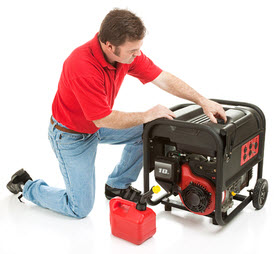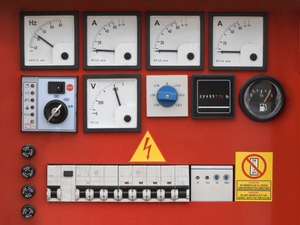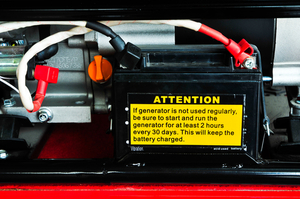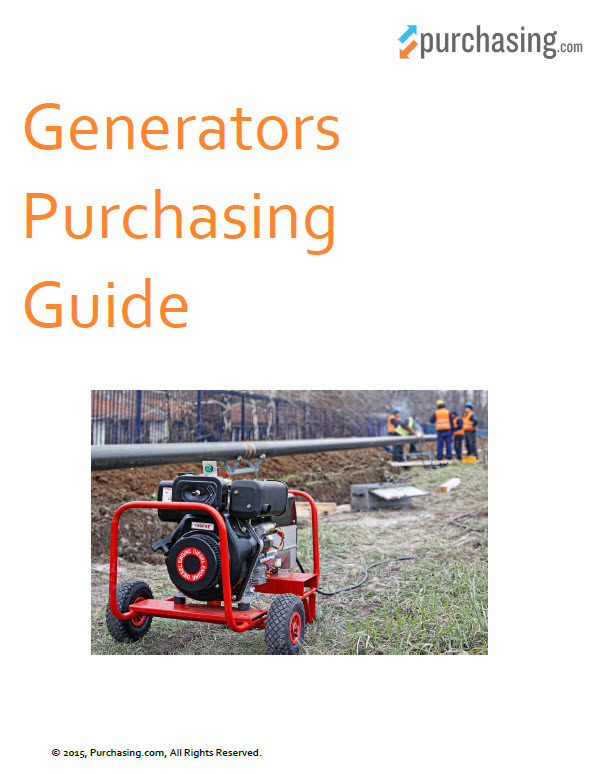Introduction to the Generator Buying Process
 Table of Contents
Table of Contents
- Introduction
- Trends
- Types
- Specs
- Features
- Choosing a Dealer
Introduction
Generators keep you up and running. Generators can power items as small as a nail gun to large infrastructure like hospitals. From a business standpoint, they play a pivotal role in your ability to meet job requirements, regardless of bad weather conditions or power outages. Industries of all types need a power supply that is flexible, portable and available on demand. The following are a few industries where generators are commonly used:
- Industrial sites. Construction contractors are frequently working on remote jobsites without access to standard power sources. Generators support power tools, air compressors, lighting systems and other essential items. Other industries using generators for similar purposes include agriculture, industrial, landscaping, and mining.
- Business buildings. In the event of a power outage, generators can keep the work going. They are capable of backing up both commercial and residential facilities with power in case of a natural disaster or other interruption of service. Grocery stores can keep food cold, hospitals can continue to provide necessary care and offices can keep processing invoices, producing quotes or maintaining documentation.
- Recreational events. Generators power campers, trailers or mobile/temporary work site buildings. They add an extra layer of fun and functionality to weekend getaways or temporary living spaces in remote work areas.
Having a generator on hand is power at your fingertips. Generators allow you to have power wherever you are, whenever you need it. You can have a backup power source in case of natural disaster, inclement weather, or otherwise disrupted service. You won't have to worry about securing buildings and facilities, protecting perishable food items, or providing emergency services and healthcare.
Buying considerations
There are many things to consider when deciding on what type generator to purchase, such as size, use, and location. Careful evaluation of your requirements and the options available will help you pick the perfect generator for your needs.
There are electric generators, powered by batteries. The batteries are charged conventionally or by a small motor on the generator. When needed, the generator is moved to the work site and started to provide power. These generators are good for jobs that do not require a lot of torque and are of short duration, and that do not require more than 4000 watts.
Standby and portable generators utilize alternative fuel sources, such as diesel, LP, natural gas or propane and bi-fuel. These generators are more rugged, have greater strength and can operate for longer periods of time. These have the most possible uses with a wattage range of 500 watts to 50,000 watts.
You also have to consider where you are going to use the generator. Inside or outside? Will it be exposed to incremental weather? Do you have a need constant and consistent power or will it be used for short bursts of activity? Here is another area in which a trusted and reliable dealer can play an invaluable role. They can best guide your decision making process and ask relevant questions about where, when and how you will use the generator.
Working with a reputable dealer when deciding on what type of generator to purchase is essential. He or she can guide you through popular models with enough power based on a description of your industry, needs and probable uses. They have extensive experience with a wide variety of customers. That knowledge provides a significant advantage and possibility of savings or cost avoidance. They can help you get the power you need without paying for power you may not ever use.
Cost
Price ranges vary considerably. You can purchase an electric generator with sufficient power for short term use for as little as $1,500. Conversely, a standby backup generator with enough power to run your essential home devices (water heater, air conditioner, and refrigerator, for example) runs about $22,000 brand new. Generators large enough to run industrial warehouses with freezers to prevent spoilage can be as much as $125,000. Heavy duty units for critical infrastructure needs, such as hospitals, can cost hundreds of thousands of dollars.
This purchasing guide will identify types and trends in generator use by industry, their specifications, and advanced features that enhance performance. It will also tell you what questions to ask a dealer in order to purchase the right kind of generator with sufficient power to meet your unique and specific needs.
Trends
 Environmental and safety concerns have influenced innovations in generator technology. Below, we explain a few trends that could impact your purchase.
Environmental and safety concerns have influenced innovations in generator technology. Below, we explain a few trends that could impact your purchase.
Low emissions and fuel options
All generators have "green modes", which allow it to run on a combination of electric, battery and fuel. By combining the sources, it reduces both emissions and your organization's carbon footprint. Your ability to use them may be affected by tank size and run time.
If you require high levels of power for extended periods of time, diesel motor powered models with a large tank will let it run longer and maintain productivity. You will have to balance your ability to meet an environmental regulations or personal preferences with the downtime associated with re-fueling.
Safety
No matter what kind of generator you elect to purchase, there are safety concerns to keep in mind, beginning with placement. All generators should be operated away from areas of heavy traffic. If the noise produced is extremely loud, the generator should be placed the proper distance away from work areas to stay within the OSHA decibel limits described in 29 CFR 1910 and 1926.
Also consider fuel transport and storage. Fuel should not be stored by the generator yet should be a reasonable distance as to not overly tax the employee charged with refueling. Large amounts of fuel on a job site may be subject to the federal Spill Prevention, Control and Countermeasure Rule (SPCC), hazardous waste regulations, and state and local fire code.
While you might have an idea of which type of generator will suit your needs, finding one with the right specifications requires careful thought and consideration of critical factors.
Back to top
Types
There are three main categories of generators: standby, portable and inverter.
Standby generators
Standby (AKA backup) generators are permanently installed units outside of a facility. They are often used for residential purposes but more commonly are utilized in commercial and emergency service sectors. They are typically installed by the dealer or an affiliated professional company. The installation requires that the building's power utility connect to it or run through it so set up is not of the "do-it-yourself" variety.
Electric standby generators will use the electric utility to charge its batteries and be wired directly into the facility's panel. Motor powered generators may be connected to your LP or propane tank as well as the electric utility. There are standby generators that you can start manually when needed.
The most popular options are automatic start generators. These generators monitor currently provided voltage and start up when there is a break in service. These models start immediately, providing a nearly seamless transition with minimal loss of power. For this reason, these models are frequently chosen for hospitals, emergency services providers, grocery stores and warehouses with frozen or perishable foods, high security areas and businesses whose backbone is computer servers and cloud storage.
Portable generators
Portable generators also come in electric and motor powered versions. The most popular are the motor powered that use diesel, LP, natural gas, propane or a combination of electric and gas as the fuel source. These versions are transportable, allowing flexibility for use in both location and application.
Portable generators are most popular in the construction industry; residential, commercial, civil, heavy construction and general contractors find them to be an invaluable resource on their remote jobsites. They are used for power tools and lighting systems to provide power to temporary office facilities, portable restrooms, air compressors, climate control and more. The possibilities are nearly limitless.
Other industries find them useful as well:
- Agriculture: They pump water in agricultural applications, such as in and out of cranberry beds to protect the fruit from frost.
- Mining: Generators are used to clear away and remove sand and soil during mining operations.
- Landscaping: They run wood chippers for brush removal in landscaping or forestry jobs.
- Manufacturing: They are even used inside warehouses and manufacturing environments to power maintenance tools for large presses and other machines that are far removed from an electrical outlet.
Portable generators are used as backup generators too. They can power the essential functions of a home or work trailer for short periods of time if the need arises, such as bad weather or a power outage. In those situations, they require constant monitoring. The generator will have to be manually started and then stopped when power is restored.
Inverter generators
Inverter generators are the most recent innovation in the market. These generators are small and lightweight for the power they produce. Their unique capability is in making greener, cleaner and purer power by producing AC power, converting it to DC power, and then inverting it back to AC power by using high-tech magnets and advanced electronic circuitry. This process produces a single phase, pure sine wave that generates the voltage and frequency using less of the fuel source with less noise and less of a carbon footprint.
The max power output of an inverter generator limits its use in commercial and industrial environments. It maxes out at 1000 to 4000 watts while portable generators produce anywhere from 500 to 50,000 watts, even more watts in standby units.
That makes inverter generators great for small spaces with infrequent uses of short duration. This generator is popular in recreational pursuits, such as camping, hiking, and fishing. However, as the technology expands to larger models with more voltage and longer run times, the significant reduction in noise will make them popular for temporary housing and portable restrooms on short-term construction jobs, harvests, cattle drives and other activities.
Back to top
Specifications
 The following specifications will help you determine what type and model of generator will best suit your business purposes. To start, the power of a generator is measured in voltage and wattage:
The following specifications will help you determine what type and model of generator will best suit your business purposes. To start, the power of a generator is measured in voltage and wattage:
- Voltage is the amount of potential energy on a circuit. In a generator, it comes in three phases - 120, 240 and 120/240.
- Wattage is calculated by taking the number of volts and number of amps produced by the generator and multiplying them. This information can be found on the manufacturer provided specification sheet, owner's manual or on the data plate on the machine.
You can determine the size generator you need by adding up how many watts you need at one time and selecting a generator that will cover that range. "Size" does not refer to length, height nor width dimensions, but instead how many watts the generator is capable of producing. Keep in mind that the starting wattage will be higher than the running wattage. Your dealer can provide you with the owner's manual and show you where the data plate is on the machine. Both places have the information in case you have to look it up again after purchase.
Fuel type only has an impact on size when you require a high watt range.
- Electric generators max out at 5,000 watts.
- Inverter generators are capable of 1,000 to 4,000 watts.
- Anything more than 5,000 watts requires a motor powered generator.
Diesel produces twice as many kilowatts as a natural gas generator so the more power you need, the more likely it is that you will end up with a diesel fueled model.
While inverter generators are more expensive because of their technology, motor powered generators are more expensive than electric generators because of the power they produce. Diesel generators cost the most upfront. Over time, however, they are the most cost effective.
[table]
Type, Size, Fuel Type, Cost, Lifetime Avg Cost
Standby, 6000W, Fuel, "$25,000", "$31,000"
Motor Powered, 7000W, Fuel, "$10,000", "$14,000"
Electric, 4000W, Battery, "$6,000", "$8,500"
Diesel, 8000W, Diesel, "$14,000", "$16,000"
Inverter, 3000W, Gasoline, "$3,000", "$6,000"
[/table]
The following table provides some examples of the type of generator, its size and an estimate of the tools it can power. It is intended to be used as a guideline for consideration. Your final decision should be based on actual wattage of your industry tools and requirements.
[table]
Type, Intended Use, Size, Fuel Type, Coolant, Capable Electric Devices, Cost, Lifetime Avg Cost
Standby, "Professional; Backup", 3000W, Diesel, Air, "Toaster, coffee maker, microwave, small refrigerator, light bulbs, furnace, small air conditioner", "$10,000", "$17,000",
Standby, "Professional; Backup", 5000W, Bi-fuel, Liquid, "Toaster, coffee maker, microwave, small refrigerator, light bulbs, furnace, small air conditioner", "$15,000", "$20,000",
Standby, "Professional; Backup", 6000W, Diesel, Air, "Up to medium central air, washing machine, stove, freezer, sump pump, grinders, saws, air compressor", "$12,000", "$16,000",
Portable, "Professional; Backup", 8000W, LP, Air, "Electric water heater, clothes dryer, large central air conditioner", "$10,000", "$14,000",
Portable, Backup; Recreational, 8000W, Natural Gas, Air, "Electric water heater, clothes dryer, large central air conditioner", "$8,500", "$12,500
Portable, Backup; Recreational, 7500W, Propane, Air, "Electric water heater, clothes dryer, large central air conditioner", "$8,000", "$12,500"
Inverter, Backup; Recreational, 4000W, Gasoline , Air, "Toaster, coffee maker, microwave, small refrigerator, light bulbs, furnace, small air conditioner", "$3,500", "$6,000",
Inverter, Backup; Recreational, 3000W, Gasoline, Air, "Toaster, coffee maker, microwave, small refrigerator, light bulbs, furnace, small air conditioner", "$3,000", "$6,000",
Inverter, Recreational, 1000W, Gasoline , Air, "Toaster, coffee maker, microwave, small refrigerator, light bulbs, furnace, small air conditioner", "$1,500", "$2,800"
[/table]
Back to top
Features
 There are additional options you can select for a generator that enhance safety, productivity and efficiency.
There are additional options you can select for a generator that enhance safety, productivity and efficiency.
Safety switches
The shut off switch automatically shuts off the generator when power is restored. For example, the power goes out due to a thunderstorm. You manually start up the generator and return to shelter. The power will come back on without warning. With the generator running, it could overload the circuits of your home or business, not to mention damage the generator as the utility voltage is added to its produced power. With an installed shut off switch, the add-on will monitor the voltage and when utility power is restored, it will automatically shut down the generator.
The transfer switch monitors voltage coming in from the connected utility. For instance, you have a standby generator for the lighting around your worksite. The electrical utility circuit is wired into the generator. The transfer switch monitors the voltage traveling through the circuit and powering your lights. When there is an interruption in that flow, the transfer switch signals the generator to start. The generator powers the lights until the voltage starts up again. The transfer switch then shuts down the generator.
Most generators will still run in a cool-down phase to protect the inner workings of the machine after the shut off or transfer switch have shut down the generator.
Enclosures
Generator enclosures protect your investment from inclement weather and other possible sources of damage. They come in solid steel or aluminum. They can store portable generators, all plugged in and ready to go, if they are going to be in one place for a period of time. They are especially useful for standby generators. They protect against animals, collision with lawn care equipment, keep children safe and protect against sun, wind and moisture damage.
Mounting pad
The mounting pad is a concrete pad placed underneath the portable or standby generator and enclosure. It provides an extra measure of protection to the unit, keeping it from sinking into soil, mud or dirt or damaging rubber parts.
Display options
LCD displays or LED status indicator lights are other safety add-on features. Lit displays or notification lights makes night time operation quicker, safer and easier for the operator. During the day, the display can show fuel level, the need for an oil change or flash warning icons. In an instant, the operator can evaluate the functionality of the equipment and any steps that need to be taken for continued safe and productive use.
Remote monitoring
Remote monitoring allows you to monitor and track the performance of your generator while away from your home or business. You can log in to web-based application on a desktop computer or use an app on your tablet or smartphone. The system will send you alerts when the generator starts and stops, runs out of fuel, needs maintenance or is in need of repair. There are remote systems that store or send data about hours run per day, fuel used and other performance metrics to you or a designated file for review and evaluation.
Back to top
Choosing a Quality Dealer
Dealers can provide valuable insights into the type, model and size of generator you need to meet your requirements. The goal is to get the best value for your dollar: a generator that gets the job done and fits into your budget. Beyond picking the right generator, there are support functions that put it in place and protect it over its life expectancy. Items like timeline for delivery, installation or service, and maintenance requirements can also have an impact on your operation and bottom line.
Installation concerns
There is no need for professionally installed portable generators; you can set it up anywhere you need it. Large standby backup generators, however, do require professional installation. Depending on the tank size, power requirements, and running times needed, the generator may need to be ordered to your specifications, especially if you select advanced features to enhance its performance. Ask about the timeline for delivery. Be prepared to pay extra if you indicate you need it urgently.
Once you know the delivery time, ask when the dealer can have it onsite and installed:
- Are there delivery charges?
- How long will it take to install it?
- Is there a charge for installation?
You should also ask if they have installed similar models before. How many have they installed recently? As manufacturers continue to improve their offerings, selecting a dealer with a knowledgeable and experienced staff becomes increasingly important. In the absence of recent installations, ask if their installers, mechanics or other staff have had training, attended classes or received manufacturer certifications.
Ask about permits. Many municipalities require that the owner obtain a permit before installing a standby generator so that they know where the unit is, what type it is, and if fuel storage is involved for their hazardous material response plan. Your dealer should be familiar with the requirements in your area. If he or she is not, protect yourself by contacting the city or county directly for additional guidance.
Service and maintenance
You are purchasing a generator because you have an identified need to have a continual power source to stay productive or protect your inventory and investment. Should there be a problem with your generator, you need to know to how it will be resolved quickly. Ask about service and support in case of emergency. Do they have 24/7/365 support? How do you get support? Some dealers offer online troubleshooting. Others offer onsite service support during business hours with the ability for after-hours service at an additional cost.
How far will the technicians travel to fix standby generators? If you are purchasing a portable generator, ask if you have to bring it back to the shop for maintenance and repair. To save time and money later, ask now so you know what you are going to get when ordering or purchasing through a particular dealer.
Another good question to ask is the number of technicians available to support their customers. While random events may occur here and there, if there is a significant occurrence affecting many customers who all may be relying on their generators at the same time, you need to know the probability of a quick repair should there be a hitch in the performance of your unit.
Get Quotes
- We contact sellers
- They compete for your business
Safety regulations
Generators are dangerous pieces of equipment. They have moving parts and generate significant power, strength and torque. They require safe operation. Ask the dealer about safety regulations that apply to the unit. Manufacturers may have precise and detailed guidance on how to operate it safely.
Be aware that other agencies have safety regulations as well. The most frequent types of accidents to occur with generator operation are shocks and electrocution. OSHA provides grounding requirements for portable generators under 29 CFR 1926.404(f)(3). Look up the applicable regulations for your type of generator, its use and abide accordingly.
Support and warranties
Beyond preventative maintenance, service, repair and safety needs, ask about additional support. Does the dealer provide training for your employees in the safe and appropriate use of the generator? Are there classes online? How about a train the trainer program? If you are on a jobsite and want to troubleshoot a field level repair, can you or your employee call a mechanic for help over the phone? The ability to ask general questions and receive timely answers is an important component in the selection process.
Ask if the dealer offers any kind of warranty. Generator operation is measured in hours. New models frequently come with a 3 year, 3000 hour warranty to replace or repair anything that may go wrong with it. Many dealers offer a limited warranty on used models too. Warranties can be voided by a lack of preventative maintenance, self-repair or add-on installations so be sure to ask your dealer about those as well.
Back to top
